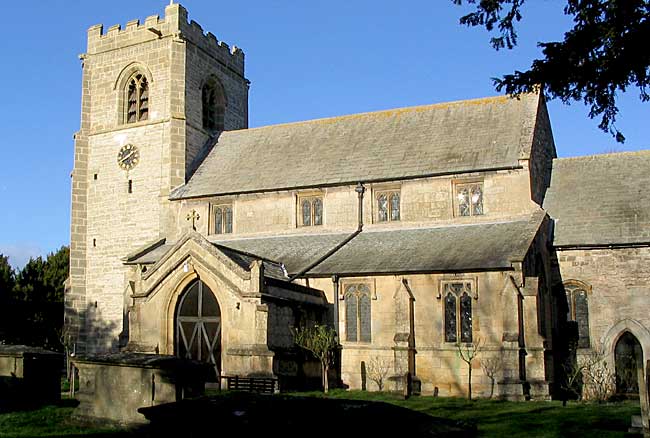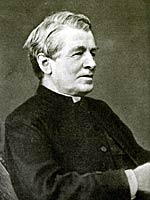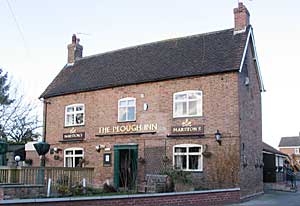
St Andrew's church, Caunton (photo: A Nicholson, 2005).
Superstitions and queer customs lingered long at Caunton
CAUNTON Church, dedicated to St. Andrew, consists of a nave, chancel, north and south aisles, small chancel aisle, south porch and an embattled western tower with three bells. The tower has a striking clock with three dials, of which two were provided at the Jubilee of 1897, the other being added to mark the accession of King George V in 1911.
Some wedge-shaped (voussoir) stones worked into the western-most, bay of the arcade betoken the existence of a Norman fabric. The chancel (rebuilt in 1869) retains its Early English arch and lancet windows. The arcades are also of that period, that on the south side being the older of the two. The ornamental south porch is of the Later Decorated order, and, like the square-headed windows—of a pattern almost peculiar to Notts.—are of 14th century date.
The tower with its arch, the clerestory windows above the arcading, and the windows on the north side are Perpendicular, probably of the time of Henry VI. and it is curious to note that when the tower was erected it stood apart from the main structure to which it was subsequently united by the addition of a bay to the nave.
The church treasures
At the west end of each aisle was a chantry chapel, each with its piscina. The chapel on the south side was endowed by Robt. Calneton (Caunton) in 1349, when the terrible Black Death was decimating the kingdom, and the adjoining recess was probably his tomb. That on the north side was dedicated to the Holy Trinity, and was associated with the Trinity Gild. The old stained glass of the church has long since gone: that now existing is mostly recent, relating to the Hole family and other worthies. The font is Early English: the pulpit is the modern successor to an older one which was ejected at the restoration of the church in 1869, and after being adapted as a summer-house, was discovered to be a fine example of silver grey oak. It is now restored to its ancient use in the beautiful church of Holme, near Newark. The organ and the panelling of the chancel are memorials to Dean Hole, who had been vicar from 1850 to 1867, after previously serving as curate, and died in 1905. The lectern is a fine specimen of modern ironwork.
A few odd particulars relating to the church may be mentioned. In 1585 Rd. Greve, of Besthorpe, bequeathed a parish chest and desired burial within the sacred fabric. In 1606, it was found that Hugh Hole, late vicar, had taken away the chest with him to Langworth, and was ordered to return it. At the same time it was discovered that "a brazen mortar with a pestle," which had been given by a former vicar for the use of the poor, and was valued at 13s. 4d., had been conveyed to the house of one John Johnson, who was ordered either to return it or pay that amount to the churchwardens. Of the vagaries of Parson Hull mention has already been made: Rd. Hughes, a successor in 1624, was also somewhat irregular, for he was fined for holding a private assembly in his house and seven years later was in trouble for "breaking the common pound" or pinfold. Another vicar, Thos. Salter, had, under the Puritan regime, been appointed rector of Winthorpe. In 1663 he resigned that living and was soon afterwards instituted to Caunton, but in 1689, having weathered the Revolution, he accommodated himself to the times and took the Oaths of Allegiance and Supremacy to William and Mary. He was the son of a shoemaker at Derby, had been educated at Cambridge and upon his appointment to Winthorpe married Helen Machin, of Car Colston.
Dismal condition of church

Dean Hole.
Unfortunately the vicar of 1743 did not trouble to reply to the visitation queries of his archbishop, and the Church conditions here two centuries ago are accordingly unknown, but Dean Hole has much to say in his various books concerning the state of things little more than a century later. "Our curate," he says, "who lived five miles away, rode over for one dreary service on the Sunday, dined, and we saw him no more during the week: he was much occupied in the pursuit of the fox. . . . The service was literally a duet between the parson and the clerk, except when old John Manners, the bricklayer, gave the keynote for the hymn from his bassoon— a sound which might have been uttered by an elephant in distress." The altar was a ricketty deal table over which faded green cloth was draped, and at service time it accommodated the parson's overcoat, hat and riding whip. ''Sparrows twittered and bats floated beneath the rotten timbers of the roof, while beetles and moths and all manner of flies found happy homes below. The damp walls represented in fresco 'a green and yellow melancholy,' which had a depressing effect upon the spirit, and the darkest and most dismal building in the parish was that called the House of God."
In his "Memories" he relates that the choir was huddled in the western gallery (which was swept away in 1869) where the village orchestra performed with its flute, clarionet, fiddles and bassoon, and the singing "was of good courage though not unanimous as to time or key." He lived to see all these conditions changed. With the gallery went the "horse-box" pews; in 1869 the flat ceiling was removed; the belfry arch was opened out, and the whole building, which was in a shocking state, was thoroughly and carefully restored at a cost of £2,000.
Old time ways
Caunton has been retentive of its old-time ways and some of its common beliefs and customs have died hard. Locally known as the "rang-tang " the custom of "riding the stang" was continued until nearly the end of the 19th century, as husbands who used their wives ill found out to their cost. In the dark of the night the offender's slumbers were broken by a serenade of penny trumpets, horns, old kettles, pokers, and fire shovels, which were lustily beaten while the "heavenly choir" chanted lines or offered critical remarks appropriate to the occasion. There was no chance of his misconduct remaining unknown under such circumstances, and the village constable turned a blind eye and a deaf ear to the disturbance. The custom lingered long, as did the village least, but the latter, not as in the Dean's earlier days when, after attending service in church and parading the village with flags and bands, the men finished the day with "two-thirds of them tipsy and the rest of them drunk." Harvest home was here observed after it had generally ceased elsewhere, the last laden wagon being drawn through the lanes in state and the harvesters regaled with a substantial meal followed by smoking, dancing, and games. Dean Hole well remembered the (yet existing) stocks being occupied by drunkards and others, and the dismantled pinfold—a reminder of other days. Superstition also lingered long, for he relates that "a man who seemed perfectly sane assured him continually that he was bewitched by a woman" of the village who persecuted him at night and, although he bolted his door, used to come and yark off the clothes from his bed." Johnny Jebb, of whom the Dean also tells, was of a bygone type—a scribe for such as could not write, a lawyer who drew up modest wills, hairdresser, fruit vendor, bird scarer and artist—a sort of epitome and general store in himself.
Village of today

The Plough Inn, Caunton (photo: A Nicholson, 2005).
But these facts relate to the colourful past, and Caunton has moved with the times. Its church and its services have been "swept and garnished" and devotion has long succeeded to disorder. Its school, established in 1840, is fully abreast of the age; its water is no longer the "pure sewage" it was in the mid-Victorian era; its scattered cottages are healthier—and almost as picturesque—than they then were. A Hole still occupies the square brick manor-house as lord of the manor, the worthy descendant of a long line of its squires, and Deane Hall exists as the farmhouse it has been for generations past.
In 1877 Middlethorpe was transferred to this parish from that of Norwell, but this was merely an administrative change. The village has not remained untouched by modern amenities and events. Near its churchyard stands its memorial of the war of 1914-18, constructed with material of the 13th century church, and the fragrance of the 1,027 rose trees which used to adorn Dean Hole's garden seems still to exhale about this retired and pleasingly rustic place.
